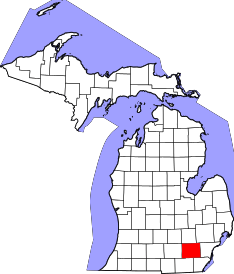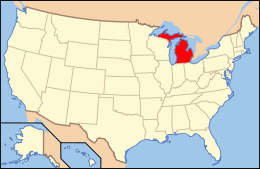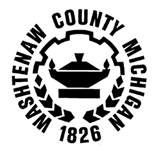Washtenaw County, Michigan
| Washtenaw County, Michigan | ||
|---|---|---|
| ||
 Location in the U.S. state of Michigan | ||
 Michigan's location in the U.S. | ||
| Founded |
1822 (created) 1826 (organized)[1][2] | |
| Seat | Ann Arbor | |
| Largest city | Ann Arbor | |
| Area | ||
| • Total | 722 sq mi (1,870 km2) | |
| • Land | 706 sq mi (1,829 km2) | |
| • Water | 16 sq mi (41 km2), 2.3% | |
| Population | ||
| • (2010) | 344,791 | |
| • Density | 488/sq mi (188/km²) | |
| Congressional districts | 7th, 12th | |
| Time zone | Eastern: UTC-5/-4 | |
| Website |
www | |
Washtenaw County /ˈwɒʃtᵻnɔː/ is a county located in the U.S. state of Michigan. As of the 2010 census, the population was 344,791.[3] The county seat is Ann Arbor.[4] The county was founded in 1822 and organized as a county in 1826.[1]
Washtenaw County comprises the Ann Arbor, MI Metropolitan Statistical Area and is included in the Detroit-Warren-Ann Arbor, MI Combined Statistical Area.
The county is home to the University of Michigan, Eastern Michigan University, Washtenaw Community College, Concordia University Ann Arbor, and the Ann Arbor campus of the Thomas M. Cooley Law School.
History
The earliest histories mention trade conducted in the area at the Potawatomi Trail and Pontiac Trail crossings of the Huron River by French traders, and later English then American settlers. The first successful settlement was established at the present site of Ypsilanti about 1809 by French traders.[5]
In 1822, the Legislative Council of the Michigan Territory government defined the name and boundaries of the county; however, it was at first administered as a part of Wayne County. The word: Washtenaw is a variant of the Ojibwe word: "Wash-ten-ong," meaning what is now called the "Grand River".[6] At the time of the official naming of the county in 1822, the headwaters of the Grand River fell within the original boundaries of Washtenaw County, which encompassed a much larger area than the current area of the county.[1] In the Ojibwe language, the word "Wash-ten-ong" literally translates as "far away waters", and was then used by the Ojibwe as the name for the Grand River due to the great length of that river.[7] Accordingly, most literally, the definition of the word "Washtenaw" could be said to mean, "far away waters".[1]
Four years after the first platting out of the county, Washtenaw county was established as a separate self-administered county by an act of the Michigan Territorial Legislature, in 1826.[5] It was attached for administrative purposes to Wayne County until {before 1829} when county government was seated. Ingham and other counties were formed from portions of territorial Washtenaw County.
Swamps were drained and farms were tiled to lower the water table. The swamp northwest of the I-94 and US-23 intersection, and areas within Waterloo Recreation Area still appear as they did to early settlers. As productive farms became established, the local deer herds grew. In the 1820s and 1830s, the events surrounding the independence of Greece from Turkey inspired construction of Greek Revival buildings, and the names of townships, towns, and children.
The "frostbitten constitutional convention" was held at Ann Arbor, the county seat, in 1835. Following resolution of the Toledo War (1835-1836), in which Michigan Territory gave up its claim to the Toledo strip in exchange for most of the Upper Peninsula, Michigan became a state on January 26, 1837. The University of Michigan, founded at Detroit in 1817, was then moved by the state to Ann Arbor in 1839 as a consolation for the city not being named the new state capital, as it had hoped. The University subsequently became and remains the largest employer in the county.
In 1849, the Michigan State Normal School (now Eastern Michigan University) was established in Washtenaw's oldest settlement, the city of Ypsilanti.
Geography
According to the U.S. Census Bureau, the county has a total area of 722 square miles (1,870 km2), of which 706 square miles (1,830 km2) is land and 16 square miles (41 km2) (2.3%) is water.[8]
Adjacent counties
- Livingston County (north)
- Oakland County (northeast)
- Wayne County (east)
- Monroe County (southeast)
- Lenawee County (southwest)
- Jackson County (west)
- Ingham County (northwest)
Major highways
 I-94
I-94 BL I-94
BL I-94 US 12 (Michigan Avenue, Chicago Road)
US 12 (Michigan Avenue, Chicago Road)
 Bus. US 12
Bus. US 12 US 23
US 23
 Bus. US 23
Bus. US 23 M-14
M-14 M-17
M-17 M-52
M-52 M-153 (Ford Road)
M-153 (Ford Road)
Demographics
| Historical population | |||
|---|---|---|---|
| Census | Pop. | %± | |
| 1830 | 4,042 | — | |
| 1840 | 23,571 | 483.2% | |
| 1850 | 28,567 | 21.2% | |
| 1860 | 35,686 | 24.9% | |
| 1870 | 41,434 | 16.1% | |
| 1880 | 41,848 | 1.0% | |
| 1890 | 42,210 | 0.9% | |
| 1900 | 47,761 | 13.2% | |
| 1910 | 44,714 | −6.4% | |
| 1920 | 49,520 | 10.7% | |
| 1930 | 65,530 | 32.3% | |
| 1940 | 80,810 | 23.3% | |
| 1950 | 134,606 | 66.6% | |
| 1960 | 172,440 | 28.1% | |
| 1970 | 234,103 | 35.8% | |
| 1980 | 264,748 | 13.1% | |
| 1990 | 282,937 | 6.9% | |
| 2000 | 322,895 | 14.1% | |
| 2010 | 344,791 | 6.8% | |
| Est. 2015 | 358,880 | [9] | 4.1% |
| U.S. Decennial Census[10] 1790-1960[11] 1900-1990[12] 1990-2000[13] 2010-2013[3] | |||
As of the 2010 United States Census, there were 344,791 people residing in the county. 74.5% were White, 12.7% Black or African American, 7.9% Asian, 0.3% Native American, 1.2% of some other race and 3.4% of two or more races. 4.0% were Hispanic or Latino (of any race). 16.0% were of German, 7.6% English, 7.5% Irish, 6.3% American and 5.0% Polish ancestry.[14]
Washtenaw has the highest proportion of Asian-American residents of any Michigan county.
As of the census[15] of 2000, 17.4% of county residents were of German ancestry; 9.0% cited English, 8.4% Irish, 5.3% Polish and 5.0% American ancestry. According to Census 2000, 87.1% spoke only English at home; 2.7% spoke Spanish and 1.7% Chinese or Mandarin.
There were 125,327 households out of which 29.20% had children under the age of 18 living with them, 46.40% were married couples living together, 9.30% had a female householder with no husband present, and 41.20% were non-families. 29.50% of all households were made up of individuals and 5.90% had someone living alone who was 65 years of age or older. The average household size was 2.41 and the average family size was 3.02.
In the county the population was spread out with 22.10% under the age of 18, 17.10% from 18 to 24, 32.10% from 25 to 44, 20.60% from 45 to 64, and 8.10% who were 65 years of age or older. The median age was 31 years. For every 100 females there were 98.90 males. For every 100 females age 18 and over, there were 97.10 males.
The median income for a household in the county was $51,990, and the median income for a family was $70,393 (these figures had risen to $59,887 and $80,779 respectively as of a 2007 estimate[16]). Males had a median income of $49,304 versus $33,598 for females. The per capita income for the county was $27,173. About 5.10% of families and 11.10% of the population were below the poverty line, including 8.60% of those under age 18 and 5.80% of those age 65 or over.
Government

Elected officials
- Prosecuting Attorney: Brian L. Mackie (Democrat)
- Sheriff: Jerry Clayton (Democrat)
- County Clerk/Register of Deeds: Lawrence Kestenbaum (Democrat)
- County Treasurer: Catherine McClary (Democrat)
- Water Resources Commissioner: Evan Pratt (Democrat)
The Board of Commissioners has nine members, elected from single member districts, on a partisan ballot, in November of even-numbered years. The term is two years. Information as of September 2016.
| District | Commissioner | Party | Positions |
|---|---|---|---|
| 1 | Kent Martinez-Kratz | Democrat | |
| 2 | Dan Smith | Republican | |
| 3 | Alicia Ping | Republican | Working Session Chair |
| 4 | Felicia Brabec | Democrat | Board Chair |
| 5 | Ruth Ann Jamnick | Democrat | |
| 6 | Ronnie Peterson | Democrat | |
| 7 | Andy LaBarre | Democrat | Ways & Means Chair |
| 8 | Yousef Rabhi | Democrat | Board Vice-Chair |
| 9 | Jen Eyer | Democrat | |
Government services
Parks and recreation
Washtenaw county operates 10 parks and one recreation center (gymnasium). These parks include one with a water sprinkler area for children to splash through, one park with a substantial water park component, and one golf course. The recreation center has a swimming pool, indoor track, basketball courts, complete set of resistance machines, a weight room, and several multipurpose rooms.
Washtenaw county is in the process of acquiring land for natural preservation. The program started in 2001, was renewed in 2010, and will end in 2021. Eight parcels of land had been purchased by July 2007. These parcels are of special ecological, recreational, and educational benefits. They are preserved in a natural unimproved state and are open to the public during daylight hours.
Wireless communication
In partnership with private enterprise, the county maintains a wireless network which is currently available to approximately 50% of county residents. This is the Wireless Washtenaw Project. The stated aim of this project is to one day provide wireless access to 100% of all county residents.
Miscellaneous
The county government operates the jail, maintains rural roads (through a largely independent road commission), operates the major local courts, keeps files of deeds and mortgages, maintains vital records, administers public health regulations, and participates with the state in the provision of welfare and other social services. The county board of commissioners controls the budget but has only limited authority to make laws or ordinances. In Michigan, most local government functions — police and fire, building and zoning, tax assessment, street maintenance, etc. — are the responsibility of individual cities and townships.
Politics
One of the most liberal counties in the United States,[17] Washtenaw has long been a Democratic stronghold in both local and national elections.
Communities
Washtenaw County was formed from a portion of Wayne County. It is one of many Michigan counties which has a name not borne by any other county in the United States. As the population increased, townships were formed. Amongst the townships, communities have grown from hamlets into villages and cities. Some of the townships have elected to incorporate as charter townships.
Cities
Villages
Charter townships
- Ann Arbor Charter Township
- Augusta Charter Township
- Pittsfield Charter Township
- Superior Charter Township
- York Charter Township
- Ypsilanti Charter Township
General law townships
Unincorporated communities
- Bridgewater
- Dixboro
- Delhi Mills
- Geddes
- Mooreville
- Rawsonville
- Salem
- Stoney Creek
- Whittaker
- Whitmore Lake
- Willis
Also see: Official Washtenaw County website page listing localities
See also
- List of Michigan State Historic Sites in Washtenaw County, Michigan
- National Register of Historic Places listings in Washtenaw County, Michigan
- USS Washtenaw County (LST-1166)
References
- 1 2 3 4 "Bibliography on Washtenaw County". Clarke Historical Library, Central Michigan University. Retrieved January 23, 2013.
- ↑ "About —". ewashtenaw.org.
- 1 2 "State & County QuickFacts". United States Census Bureau. Retrieved August 29, 2013.
- ↑ "Find a County". National Association of Counties. Retrieved 2011-06-07.
- 1 2 Chas. C. Chapman & Co. (1881). History of Washtenaw County, Michigan, Vol. 1, pp. 116-24. Chicago: Chas. C. Chapman & Co.
- ↑ "Washtenaw County Historical Society: Etymology of the Name". 2013. Retrieved 2013-01-23. Washtenaw County Historical Society detail of etymology of the county's name.
- ↑ Publications of the Historical Society of Grand Rapids, Volume 1, Parts 1-7. 2013. Retrieved 2013-01-23. Ojibwe etymology of the word: Wash-ten-ong".
- ↑ "2010 Census Gazetteer Files". United States Census Bureau. August 22, 2012. Retrieved September 28, 2014.
- ↑ "County Totals Dataset: Population, Population Change and Estimated Components of Population Change: April 1, 2010 to July 1, 2015". Retrieved July 2, 2016.
- ↑ "U.S. Decennial Census". United States Census Bureau. Retrieved September 28, 2014.
- ↑ "Historical Census Browser". University of Virginia Library. Retrieved September 28, 2014.
- ↑ "Population of Counties by Decennial Census: 1900 to 1990". United States Census Bureau. Retrieved September 28, 2014.
- ↑ "Census 2000 PHC-T-4. Ranking Tables for Counties: 1990 and 2000" (PDF). United States Census Bureau. Retrieved September 28, 2014.
- ↑ Data Access and Dissemination Systems (DADS). "American FactFinder". census.gov.
- ↑ "American FactFinder". United States Census Bureau. Retrieved 2008-01-31.
- ↑ Washtenaw County, Michigan - Fact Sheet - American FactFinder
- ↑
External links
| Wikivoyage has a travel guide for Washtenaw County. |
- Dexter District Library
- Washtenaw County Government
- Past and present of Washtenaw County, Michigan by Samuel W. Beakes Chicago: The S.J. Clarke publishing co., 1906.
- Washtenaw Community Cafe An online discussion group for the county of Washtenaw.
- Ypsilanti Historical Society
 |
Ingham County | Livingston County | Oakland County |  |
| Jackson County | |
Wayne County | ||
| ||||
| | ||||
| Lenawee County | Monroe County | Monroe County |
Coordinates: 42°15′N 83°50′W / 42.25°N 83.84°W

